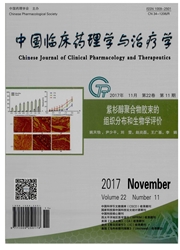

 中文摘要:
中文摘要:
目的:研究与复方新诺明合用对罗格列酮在体内的代谢动力学参数的影响,对二者在临床合用的安全性进行探讨。方法:采用随机、双盲、双周期交叉方法,测定10名中国男性健康志愿者在连续口服复方新诺明4.5d(每天2次,每次1g)后,单次口服4mg罗格列酮后各时间点时的血浆药物浓度,计算出罗格列酮在体内相关药代动力学参数。采用HPLC-MS/MS法测定血浆中罗格列酮及其主要代谢产物N-去甲基罗格列酮的浓度。结果:复方新诺明与罗格列酮合用时,对罗格列酮及其主要代谢产物N-去甲基罗格列酮的血药峰浓度(Cmax)和达峰时间(tmax)没有影响(P〉0.05),但罗格列酮的AUG0-48增加了40%(P=0.000)[从(6768±900)ng·mL^-1·h改变为(9485±1638)ng·mL^-1·h)],半衰期t1/2延长了44%(P=0.007)[由(4.4±0.8)h延长至4(6.1±1.2)h],N-去甲基罗格列酮转化率的AUG0-48降低为59.8%(P=0.001)。结论:复方新诺明降低罗格列酮转化率,增加血浆罗格列酮浓度。
 英文摘要:
英文摘要:
AIM: To investigate the effect of compound sulfamethoxazole on the rosiglitazone pharmacokinetics in normal Chinese subjects and assess the safety when they are coadministrated in clinic. METHODS: Ten male healthy volunteers completed a randomized, two-period, double-blind crossover study. Volunteers received single dose rosiglitazone (4 mg) in the presence and absence of compound sulfamethoxazole lg given twice daily for 4.5 days. The plasma drug concentrations were determined at each time point after oral rosiglitazone. The related phmanacokinetical parameters in vivo were computed. The concentrations of rosiglitazone and N-demethylrosiglitazone were assessed by HPLC-MS/MS. RESULTS: The Cmax, and tmax, of rosiglitazone and N-demethylrosiglitazone were not changed by compound sulfamethoxazole treatment,respectively( P 〉0.05). But the AUG0-48 of rosiglitazone was increased by 40% ( P = 0.000) from (6768±900) ng.mL^-1.h to (9485±1638) ng.mL^-1.h, and the tmax, was increased by 44 % ( P = 0. 007) from (4.4±0.8) to (6.1±1.2) h. The AUG0-48 of biotransformation rate of N-demethylmsiglitazone/rosiglitazone was decreased to 59.8% (P = 0.001). CONCLUSION: Compound sulfamethoxazole decreases the rosiglitazone biotransformation rate and increases the plasma rosiglitazone concentrations in healthy volunteers when they are co-administrated.
 同期刊论文项目
同期刊论文项目
 同项目期刊论文
同项目期刊论文
 LC-MS-MS Quantitative Determination of Ursolic Acid in Human Plasma and Its Application to Pharmacok
LC-MS-MS Quantitative Determination of Ursolic Acid in Human Plasma and Its Application to Pharmacok Inhibition of organic anion-transporting polypeptide1B1 by quercetin: an in vitro and in vivo assess
Inhibition of organic anion-transporting polypeptide1B1 by quercetin: an in vitro and in vivo assess LC-MS-MS Quantitative Determination of Brivudine in Human Plasma and Its Application to Pharmacokine
LC-MS-MS Quantitative Determination of Brivudine in Human Plasma and Its Application to Pharmacokine 期刊信息
期刊信息
